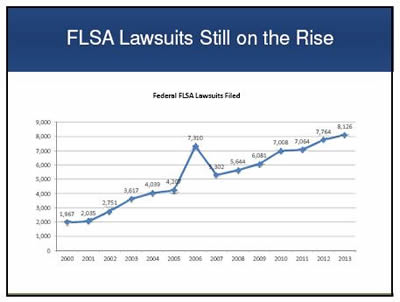Compliance ROI—The Cost of Noncompliance
Last year was a record year for federal court lawsuits, says McCutchen. We broke the 8,000 mark.

Some notable suits you can use as ammo for convincing bosses to take action about wage/hour violations:
- Novartis, $99
- Walmart, $85 million
- Staples, $80 million
- Wachovia, $50 million
- Merrill Lynch, $44 million
- JPMorgan, $42 million
- Oracle, $35 million
- CVS, $34 million
- Tyson Foods, $32 million
- Lowes, $29.5 million
- Ecolab, $29 million
- AT&T, $29 million
- Perdue, $20 million
Top 5 Settlements of 2013
- Puerto Rico Department of Correction—$35 million to 4,500 employees for alleged compensatory time violations
- 24 Hour Fitness—$17.5 million to 860 employees for alleged off-the-clock work by trainers and misclassification of managers
- Roto-Rooter Services—$14.3 million for alleged misclassification of service technicians
- Old Republic Title Company—$12 million to 1,100 employees for alleged meal break violations and off-the-clock work
- Tesoro Refining and Marketing—$11.6 million to 700 employees alleged meal violations
HR budget cuts? Let us help. HR.BLR.com is your one-stop solution for all your HR compliance and training needs. Take a no-cost, no-obligation trial and get a complimentary copy of our special report Critical HR Recordkeeping—From Hiring to Termination. It’s yours—no matter what you decide.
Reading Timekeeping and Payroll Records
There are five key documents that investigators use (and that you can use) to find wage/hour violations, says McCutchen:
- Earnings Code List (shows regular hours, overtime hours, etc.)
- Deduction Code List (shows 401(k), insurance, tax deductions, etc.)
- Time Clock Rules (particularly rounding, shifts that cross a time period)
- Time Records (a sampling, say one from Christmas and one from June)
- Paystubs/Earnings Statements (for comparison)
A review of your company’s earnings codes is often the best and quickest way to identify compensation that is being improperly excluded from the regular rate:
- 1 REG HRLY
- 2 OT HRLY
- 3 DT HRLY
- 4 SALARY
- 6 SAFETY*
- 7 INCENTIVE*
- 10 VACATION
- 11 SICK PAY
- 12 HOLIDAY
- 20 BONUS*
- 25 SHIFT PREMIUM
- 30 S/T DISABILITY
- 40 HEALTH INS PRE TAX
- 47 HSA – PRETAX
- 50 401(k)
- 61 AUTO ALLOW*
- 63 OPERATOR INCENTIVE*
- 68 PER DIEM*
*Starred items are where investigators tend to focus their energies. For example, with “Per Diem,” if the amount is small, it may indicate a minimum wage problem; if the amount is high, excess over actual expenses may need to go into the hourly rate.
A review of a list of deduction codes can also identify problems:
- Potential for deductions that could improperly reduce wages below minimum wage
- Deductions for which a prior authorization from the employee is needed
Deduction Code List
- ADD AD&D
- WHL Whole Life
- DEN Dental Post-Tax
- MED Medical Insurance
- GAR Garnishment
- LOA 401k Loan
- SHO Shoes*
- ADV Advance*
- UNF Uniform*
- TAX Tax Levy
- CHS Child Support
- UDU Union Dues*
- LND Laundry*
- MIS Misc*
- GLA Safety Glasses*
- SAV US Savings Bond
- TLS Tools*
*Starred items are particularly interesting to investigators. Again, the issues are whether they are appropriate deductions, whether permission to deduct has been obtained where needed, and whether the deduction takes the employee below the minimum wage.
Time Clock Rules
Time clock rules that interpret employee time punches can sometimes cause wage and hour violations, says McCutchen.
- Rounding rules (Make sure you are not always rounding down.)
- Automatic meal period deductions (Really bad, says McCutcheon. No single practice has led to more litigation. Many companies settle this type of litigation because it is hard for employers to prove that employees ate lunch.)
- Rules on clocking in early or late (Be sure that rules treat employees equitably.)
- Assigning hours in a shift that spans 2 workweeks (If you assign all to the first week or all to the second week, this results in overpaying one week and underpaying the other week.)
Time Record Red Flags
There are several red flags for investigators looking at time records.
- Same in and out times for almost every day.
- Same out/in time for meal periods every day.
- No out/in times for meal periods.
- Time punches are always at the exact time that the shift begins. (What judge and jury will believe this?)
- Time punches for all or most employees are almost the same exact time. (One employee is punching in all employees.)
Find out what the buzz is all about. Take a no-cost look at HR.BLR.com, solve your top problem, and get a complimentary gift.
Pay Stub Red Flags
- An employee is paid for fewer hours than shown on his or her time records.
- The pay stub shows deductions for equipment required to work (e.g., safety glasses, boots).
- The overtime pay rate is 1.5 times the employee’s hourly rate, but the pay stub shows the employee was paid a shift differential or bonus.
In tomorrow’s Advisor, McCutchen’s best practices for wage and hour compliance, plus an introduction to the unique 50 Employment Laws in 50 States.
